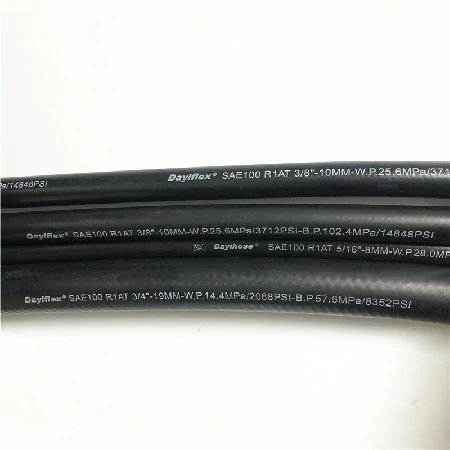1 月 . 07, 2025 10:16 Back to list
hydraulic hose
In the realm of construction, agriculture, and manufacturing, the hydraulic hose serves as a critical component in the smooth functioning of hydraulic systems. It is more than just a conduit for hydraulic fluid; it is a lifeline that ensures operational efficiency, safety, and reliability in some of the most demanding environments. Understanding the nuances of hydraulic hoses can transform how industries perceive their integral roles in various applications.

Hydraulic hoses are engineered to endure high pressure and harsh environmental conditions. Their structure typically comprises inner tubes compatible with the hydraulic fluid, a reinforcement layer for strength, and an outer cover for protection against abrasion and weathering. Such a design ensures robustness and flexibility, characteristics essential for dynamic machinery movements in restricted spaces.
Experience speaks volumes about the importance of choosing the right type of hydraulic hose for specific operations. For instance, in the construction industry, excavators subject their hoses to immense pressure and frequent sharp bending. Opting for a hose with superior flexibility and higher pressure ratings ensures longevity and reduces downtimes due to hose failures. Similarly, in agricultural equipment, where exposure to harsh chemicals and UV light is common, selecting a hose with chemical and UV-resistant properties can significantly enhance performance and reduce maintenance costs.

Expertise in hydraulic hose selection requires understanding the “STAMPED” criteria – Size, Temperature, Application, Media, Pressure, Ends, and Delivery. This checklist serves as a guide for determining the right hose for a job. It not only increases operational efficiency but also safeguards personnel by minimizing the risks of hose bursts and leaks. Fluid compatibility is crucial; using a hose material that reacts adversely with the hydraulic fluid can lead to degradation and failure, underscoring the importance of material knowledge in hose selection.
hydraulic hose
From an authoritative perspective, adhering to industry standards such as those defined by SAE (Society of Automotive Engineers) and ISO (International Organization for Standardization) is non-negotiable. These standards govern hose dimensions, performance requirements, and testing methods, ensuring safety and quality across applications. For businesses, compliance with such standards is a testament to a commitment to safety and reliability, enhancing trust with stakeholders.
Trustworthiness in hydraulic hose manufacturing and supply cannot be overstated. The choice of supplier impacts not only the product quality but also the after-sale support and availability of technical expertise. Reputable manufacturers invest in research and development to innovate and improve hose materials and designs, which translates to better performance and longer service life. Additionally, transparent communication regarding product specifications and limitations fosters trust and facilitates informed decision-making.
In conclusion, the hydraulic hose is an indispensable element in modern hydraulics, its role woven into the fabric of industrial efficiency and safety. Leveraging experience, expertise, authority, and trust in their selection and application not only enhances operational performance but also protects investments and lives. As industries evolve, so too must the approaches to hydraulic hose technology, embracing advancement to ensure continued reliability and success in demanding applications.
-
EN857 2SC Hydraulic Hose Suppliers OEM & China Manufacturers
NewsMay.30,2025
-
51mm Hydraulic Hose Manufacturer China OEM Durable & Custom Solutions
NewsMay.30,2025
-
OEM Rubber Air Hose Supplier Durable Custom Solutions
NewsMay.29,2025
-
High-Pressure Wrapped Cover Steel Wire Spiral Hydraulic Hose Supplier
NewsMay.29,2025
-
Rubber water suction and discharge hose
NewsMar.07,2025
-
SAE 100 R6/EN 854 R6 Fibre Braided Oil Hose
NewsMar.07,2025



